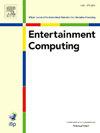Deep analysis on the color language in film and television animation works via semantic segmentation technique
IF 2.4
3区 计算机科学
Q2 COMPUTER SCIENCE, CYBERNETICS
引用次数: 0
Abstract
In film and television animation works, colour is an ideographic symbol distinct from other elements. Color language and image language are separate concepts, with image language unable to fully capture the ideographic nature of color. Even when images appear visually similar, differences in brightness can create significant contrasts or opposing meanings. Thus, color language plays an ideographic role between color and concept. This paper uses semantic segmentation techniques to integrate the three modalities of color content and text, establishing a consistent representation relationship. We propose a color-depth (RGB-D) image semantic segmentation method based on two-stream weighted Gabor convolutional network fusion. To capture Orientation- and scale-invariant features, we design a weighted Gabor orientation filter within a deep convolutional network (DCN) to adapt to changes in Orientation and scale. A wide residual-weighted Gabor convolutional network extracts features from the dual-stream images of colour and depth. To quantitatively assess our method’s representational ability regarding the ideographic functions of color language, we conduct extensive experiments on public datasets. The results demonstrate that the proposed algorithm outperforms existing RGB-D image semantic segmentation methods. Specifically, the technique achieves superior accuracy across several performance metrics, with a notable improvement of 2.5%–6.6% compared to baseline models. Our approach enhances segmentation precision for objects of varying scales and directions. It exhibits robustness in complex lighting environments, thus confirming its potential in real-world applications of color language in animation.
利用语义分割技术对影视动画作品中的色彩语言进行深入分析
在影视动画作品中,色彩是一种区别于其他元素的表意符号。色彩语言和形象语言是两个独立的概念,形象语言无法充分捕捉色彩的表意性。即使图像在视觉上看起来相似,亮度的差异也会产生明显的对比或相反的含义。因此,色彩语言在色彩与概念之间起着表意的作用。本文利用语义分割技术将颜色内容和文本的三种形态进行整合,建立一致的表示关系。提出了一种基于两流加权Gabor卷积网络融合的颜色深度(RGB-D)图像语义分割方法。为了捕获方向和尺度不变的特征,我们在深度卷积网络(DCN)中设计了加权Gabor方向滤波器,以适应方向和尺度的变化。宽残差加权Gabor卷积网络从颜色和深度的双流图像中提取特征。为了定量评估我们的方法在颜色语言表意功能方面的表征能力,我们在公共数据集上进行了大量的实验。结果表明,该算法优于现有的RGB-D图像语义分割方法。具体来说,该技术在几个性能指标上实现了卓越的准确性,与基线模型相比,显著提高了2.5%-6.6%。该方法提高了对不同尺度和方向目标的分割精度。它在复杂的照明环境中表现出鲁棒性,从而证实了它在动画中色彩语言的实际应用中的潜力。
本文章由计算机程序翻译,如有差异,请以英文原文为准。
求助全文
约1分钟内获得全文
求助全文
来源期刊

Entertainment Computing
Computer Science-Human-Computer Interaction
CiteScore
5.90
自引率
7.10%
发文量
66
期刊介绍:
Entertainment Computing publishes original, peer-reviewed research articles and serves as a forum for stimulating and disseminating innovative research ideas, emerging technologies, empirical investigations, state-of-the-art methods and tools in all aspects of digital entertainment, new media, entertainment computing, gaming, robotics, toys and applications among researchers, engineers, social scientists, artists and practitioners. Theoretical, technical, empirical, survey articles and case studies are all appropriate to the journal.
 求助内容:
求助内容: 应助结果提醒方式:
应助结果提醒方式:


